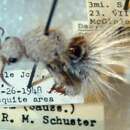en
names in breadcrumbs


Dasymutilla gloriosa, sometimes referred to as the thistledown velvet ant,[1][2] is a member of the genus Dasymutilla. Only females are wingless, as in other mutillids. Compared to other mutillids, it is mid-sized, being larger than some of the smallest known species like Dasymutilla vesta but smaller than some of the largest known species like Dasymutilla klugii.[3] It ranges from Utah, Nevada, California, Arizona, New Mexico, Texas and south into Mexico.
Rather than having aposematic coloration like other mutillids, the females of this species are camouflaged by their resemblance to the fruit of Creosotebush, which occurs in the same habitats. However, this species' coloration appears to be primarily an adaptation to hot desert conditions instead of predation pressure; their internal and external body temperature are less compared to orange Dasymutilla species in the same habitat.[2]
Like other mutillids, the females of this species can administer a very painful sting as a defense mechanism. Being a mid-sized mutillid, the sting delivered is more powerful than most smaller mutillids', but weaker than most larger mutillids'.[3]
Dasymutilla gloriosa, sometimes referred to as the thistledown velvet ant, is a member of the genus Dasymutilla. Only females are wingless, as in other mutillids. Compared to other mutillids, it is mid-sized, being larger than some of the smallest known species like Dasymutilla vesta but smaller than some of the largest known species like Dasymutilla klugii. It ranges from Utah, Nevada, California, Arizona, New Mexico, Texas and south into Mexico.
Rather than having aposematic coloration like other mutillids, the females of this species are camouflaged by their resemblance to the fruit of Creosotebush, which occurs in the same habitats. However, this species' coloration appears to be primarily an adaptation to hot desert conditions instead of predation pressure; their internal and external body temperature are less compared to orange Dasymutilla species in the same habitat.
Like other mutillids, the females of this species can administer a very painful sting as a defense mechanism. Being a mid-sized mutillid, the sting delivered is more powerful than most smaller mutillids', but weaker than most larger mutillids'.
Dasymutilla gloriosa (лат.) — вид ос-немок (бархатных муравьёв) рода Dasymutilla из подсемейства Sphaeropthalminae (триба Pseudomethocini). Эндемик Северной Америки[1].
Северная Америка: Мексика (северо-восток), США (юго-запад: Калифорния, Айдахо, Невада, Техас). Пустынные области (Chihuahuan, Mojave, Peninsular, Sonoran)[1].
Мелкие пушистые осы-немки, длина тела около 1 см. Самки отличаются от близких видов длинным белым опушением, напоминающим некоторые семена с волосками. Например, креозотовый куст (Larrea tridentata из семейств Парнолистниковые), с которым имеют перекрывающиеся области распространения. Самцы в основном покрыты чёрными волосками (голова, ноги, низ и бока груди, передняя часть брюшка), кроме части тела, которая несёт оранжевое опушение на верхней части груди и задней половине брюшка. Мезосома самок длиннее своей ширины; пигидиум с отчётливыми бороздками. Характерен половой диморфизм: самки бескрылые, самцы крылатые. Паразиты в гнёздах жалящих перепончатокрылых насекомых, где они откладывают свои яйца в личинки хозяев этого гнезда. Личинки ос-немок питаются личинками хозяев в их гнёздах и там же окукливаются. Имаго питаются нектаром[1][2][3].
Вид был впервые описан в 1868 году швейцарским энтомологом Анри де Соссюром (Henri de Saussure, 1829—1905) под первоначальным названием Mutilla gloriosa Saussure, 1868[4] и в дальнейшем был неоднократно переописан под сведёнными в синонимы другими именами. Валидный статус вида был подтверждён в ходе ревизии группы в 2000-е годы американскими энтомологами Кевином Уилльямсом (англ. Kevin A. Williams) и Джеймсом Питтсом (James P. Pitts, оба из Университета штата Юта, Logan, Юта) и их соавторами. Таксон обладает сходством в окраске и опушении с видами Dasymutilla pseudopappus (Cockerell, 1895) и Dasymutilla thetis (Blake, 1886). Филогенетический анализ показал, что D. gloriosa и D. pseudopappus дивергировали от их ближайших родственников 5,4 и 10,0 млн лет, соответственно[1][5].
Dasymutilla gloriosa (лат.) — вид ос-немок (бархатных муравьёв) рода Dasymutilla из подсемейства Sphaeropthalminae (триба Pseudomethocini). Эндемик Северной Америки.